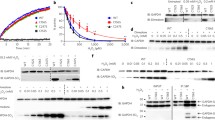Abstract
Glutathione peroxidases (Gpxs) are the key anti-oxidant enzymes found in Saccharomyces cerevisiae. Among the three Gpx isoforms, glutathione peroxidase 3 (Gpx3) is ubiquitously expressed and modulates the activities of redox-sensitive thiol proteins involved in various biological reactions. By using a proteomic approach, glyceraldehyde-3-phosphate dehydrogenase 2 (GAPDH2; EC 1.2.1.12) was found as a candidate protein for interaction with Gpx3. GAPDH, a key enzyme in glycolysis, is a multi-functional protein with multiple intracellular localizations and diverse activities. To validate the interaction between Gpx3 and GAPDH2, immunoprecipitation and a pull-down assay were carried out. The results clearly showed that GAPDH2 interacts with Gpx3 through its carboxyl-terminal domain both in vitro and in vivo. Additionally, Gpx3 helps to reduce the S-nitrosylation of GAPDH upon nitric oxide (NO) stress; this subsequently increases cellular viability. On the basis of our findings, we suggest that Gpx3 protects GAPDH from NO stress and thereby contributes to the maintenance of homeostasis during exposure to NO stress.
Similar content being viewed by others
References
Abat, J.K., Saigal, P., and Deswal, R. (2008). S-nitrosylation — another biological switch like phosphorylation. Physiol. Mol. Biol. Plants 14, 119–130.
Chuang, D.M., Hough, C., and Senatorov, V.V. (2005). Glyceraldehyde-3-phosphate dehydrogenase, apoptosis, and neurodegenerative diseases. Annu. Rev. Pharmacol. Toxicol. 45, 269–290.
Delaunay, A., Pflieger, D., Barrault, M.B., Vihn, J., and Toledano, M.B. (2002). A thiol peroxidase is an H2O2 receptor and redoxtransducer in gene activation. Cell 111, 471–481.
Delledonne, M. (2005). NO news is good news for plants. Curr. Opin. Plant Biol. 8, 390–396.
Derakhshan, B., Wille, P.C., and Gross, S.S. (2007). Unbiased identification of cysteine S-nitrosylation sites on proteins. Nat. Prot. 2, 1685–1691.
Hara, M.R., Agrawal, N., Kim, S.F., Cascio, M.B., Fujimuro, M., Ozeki, Y., Takahashi, M., Cheah, J.H., Tankou, S.K., Hester, L.D., et al. (2005). S-nitrosylated GAPDH initiates apoptotic cell death by nuclear translocation following Siah1 binding. Nat. Cell Biol. 7, 665–674.
Hara, MR., Cascio, M.R., and Sawa, A. (2006). GAPDH as a sensor of NO stress. Biochim. Biophys. Acta 1762, 502–509.
Hess, D.T., Matsumoto, A., Kim, S.O., Marshall, H.E., and Stamler, J.S. (2005). Protein S-nitrosylation: purview and parameters. Nat. Rev. Mol. Cell Biol. 6, 150–166.
Ignarro, L.J., Buga, G.M., Wood, K.S., Byrns, R.E., and Chaudhuri, G. (1987). Endothelium-derived relaxing factor produced and released from artery and vein is nitric oxide. Proc. Natl. Acad. Sci. USA 84, 9265–9269.
Ikemoto, A., Bole, D.G., and Ueda, T. (2003). Glycolysis and glutamate accumulation into synaptic vesicles. J. Biol. Chem. 278, 5929–5940.
Inoue, Y., Matsuda, T., Sugiyama, K., Izawa, I., and Kimura, A. (1999). Genetic analysis of glutathione peroxidase in oxidative stress response of Saccharomyces cerevisiae. J. Biol. Chem. 274, 27002–27009.
Kho, C.W., Lee, P.Y., Bae, K.-H., Cho, S., Lee, Z.W., Park, B.C., Kang, S., Lee, D.H., and Park, S.G. (2006). Glutathione peroxidase 3 of Saccharomyces cerevisiae regulates the activity of methionine sulfoxide reductase in a redox state-dependent way. Biochem. Biophys. Res. Commun. 348, 25–35.
Lee, P.Y., Bae, K.-H., Kho, C.W., Kang, S., Lee, D.H., Cho, S., Kang, S., Lee, S.C., Park, B.C., and Park, S.G. (2008). Interactome analysis of yeast glutathione peroxidase 3. J. Microbiol. Biotechnol. 18, 1364–1367.
Lee, H., Chi, S.-W., Lee, P.Y., Kang, S., Cho, S., Lee, C.-K., Bae, K.-H., Park, B.C., and Park, S.G. (2009). Reduced formation of advanced glycation endproducts via interactions between glutathione peroxidase 3 and dihydroxyacetone kinase 1. Biochem. Biophys. Res. Commun. 389, 178–180.
Meyer-Sieglar, K., Mauro, D.J., Seal, G., Wurzer, J., Deriel, J.K., and Sirover, M.A. (1991). A human nuclear uracil DNA glycosylase is the 37-kDa subunit of glyceraldehyde-3-phosphate dehydrogenase. Proc. Natl. Acad. Sci. USA 88, 8460–8464.
Michael, A.S. (1999). New insights into an old protein: the functional diversity of mammalian glyceraldehyde-3-phosphate dehydrogenase. Biochim. Biophys. Acta 1432, 159–184.
Nathan, C. (1992). Nitric oxide as a secretory product of mammalian cells. FASEB J. 6, 3051–3064.
Nilkantha, S., Hara, M.R., Kornberg, M.D., Cascio, M.B., Bae, B.I., Shahani, N., Thomas, B., Dawson, T.D., Dawson, V.L., Snyder, S.H., et al. (2008). Nitric oxide-induced nuclear GAPDH activates p300/CBP and mediates apoptosis. Nat. Cell Biol. 10, 866–873.
Sies, H., and Cadenas, E. (1985). Oxidative stress: damage to intact cells and organs. Philos. Trans. R. Soc. Lond. B. Biol. Sci. 311, 617–631.
Singh, R., and Green, M.R. (1993). Sequence-specific binding of transfer RNA by glyceraldehyde-3-phosphate dehydrogenase. Science 259, 365–368.
Soriano, F.X., Baxter, P., Murray, L.M., Sporn, M.B., Gillingwater, T.H., and Hardingham, G.E. (2009). Transcriptional regulation of the AP-1 and Nrf2 target gene sulfiredoxin. Mol. Cells 27, 279–282.
Stamler, J.S., Lamas, S., and Fang, F.C. (2001). Nitrosylation: the prototypic redox-based signaling mechanism. Cell 106, 675–683.
Tisdale, E.J. (2001). Glyceraldehyde-3-phosphate dehydrogenase is required for vesicular transport in the early secretory pathway. J. Biol. Chem. 276, 2480–2486.
Yoon, S.O., Yun, C.H., and Chung, A.S. (2002). Dose effect of oxidative stress on signal transduction in aging. Mech. Aging Dev. 123, 1597–1604.
Author information
Authors and Affiliations
Corresponding authors
Additional information
These authors contributed equally to this work.
About this article
Cite this article
Lee, P.Y., Bae, KH., Jeong, D.G. et al. The S-nitrosylation of glyceraldehyde-3-phosphate dehydrogenase 2 is reduced by interaction with glutathione peroxidase 3 in Saccharomyces cerevisiae . Mol Cells 31, 255–259 (2011). https://doi.org/10.1007/s10059-011-0029-3
Received:
Revised:
Accepted:
Published:
Issue Date:
DOI: https://doi.org/10.1007/s10059-011-0029-3




